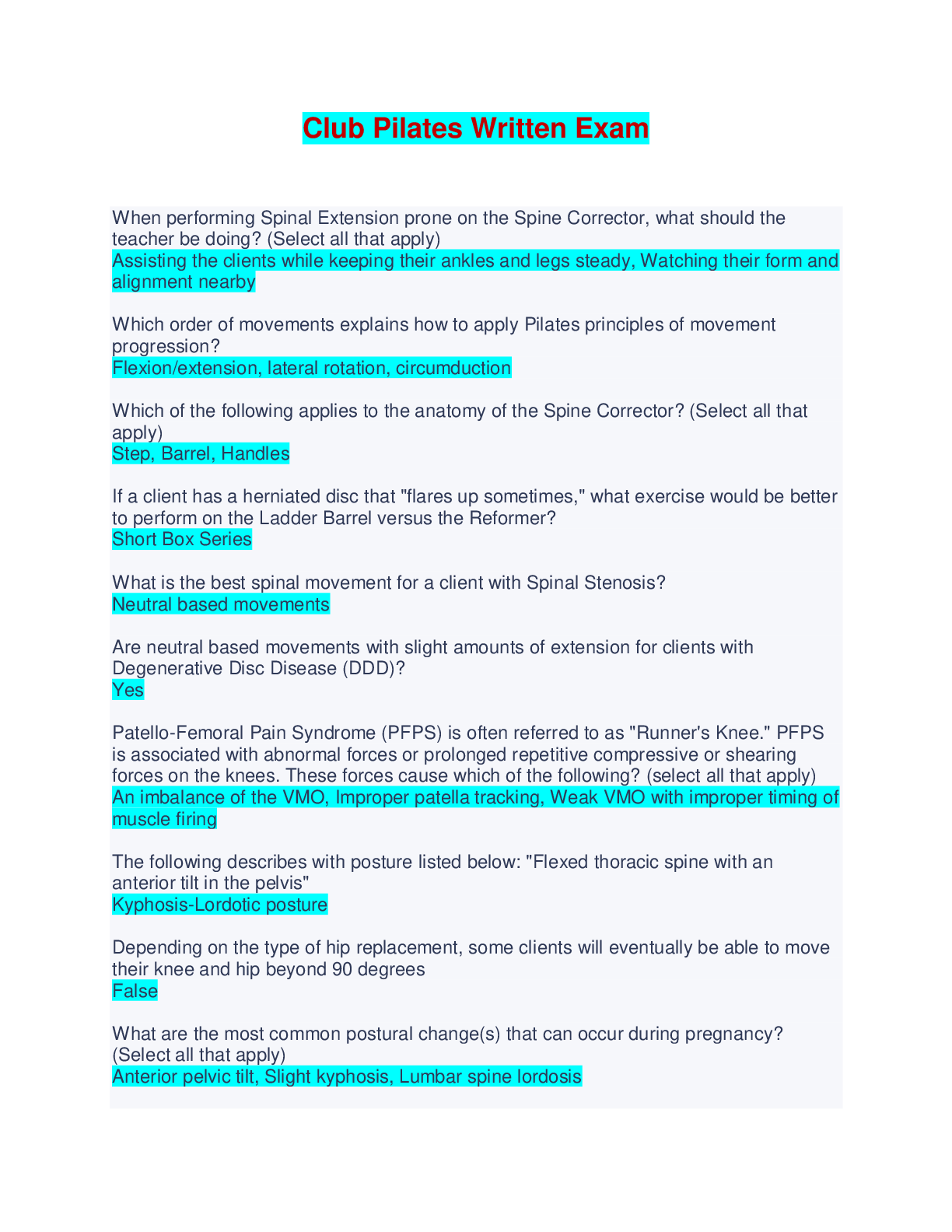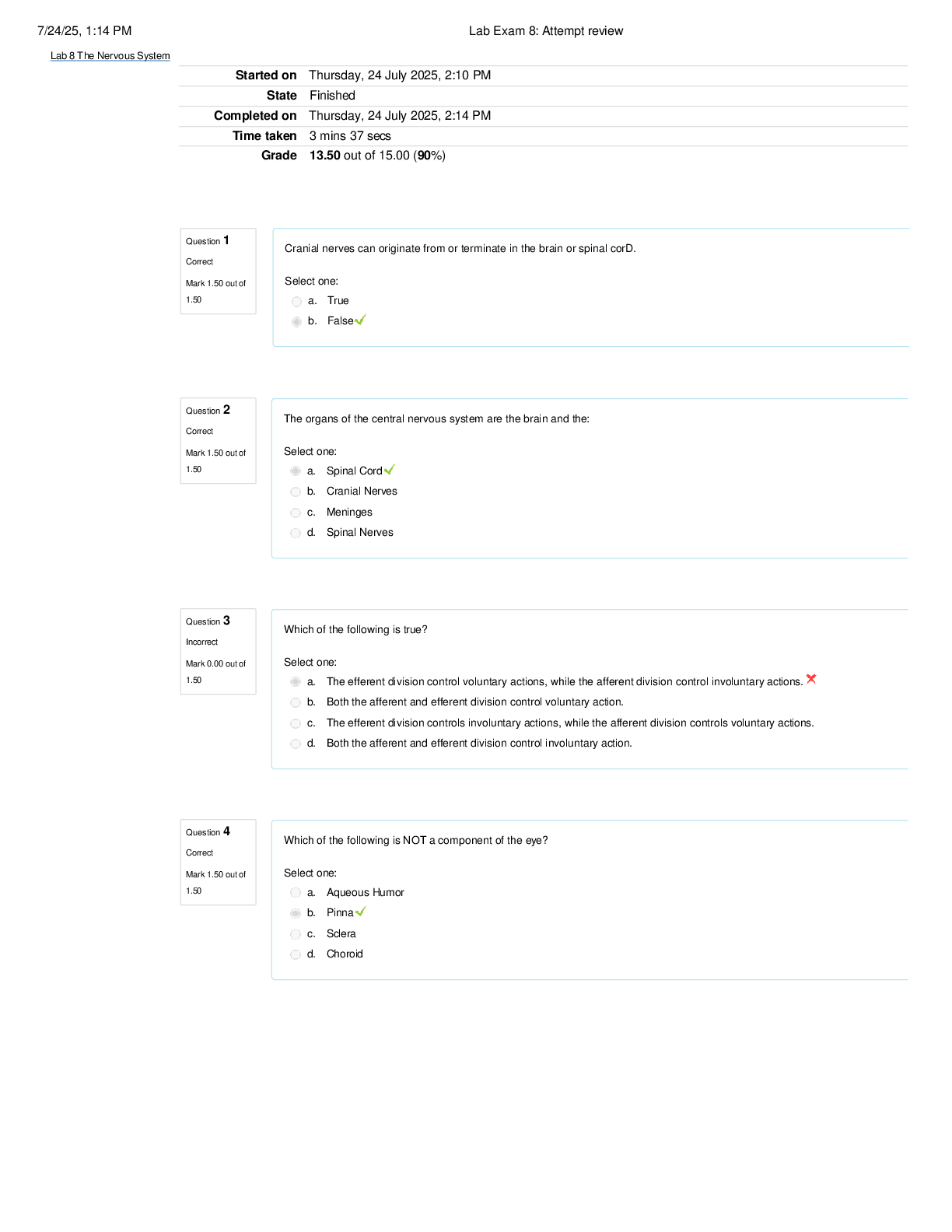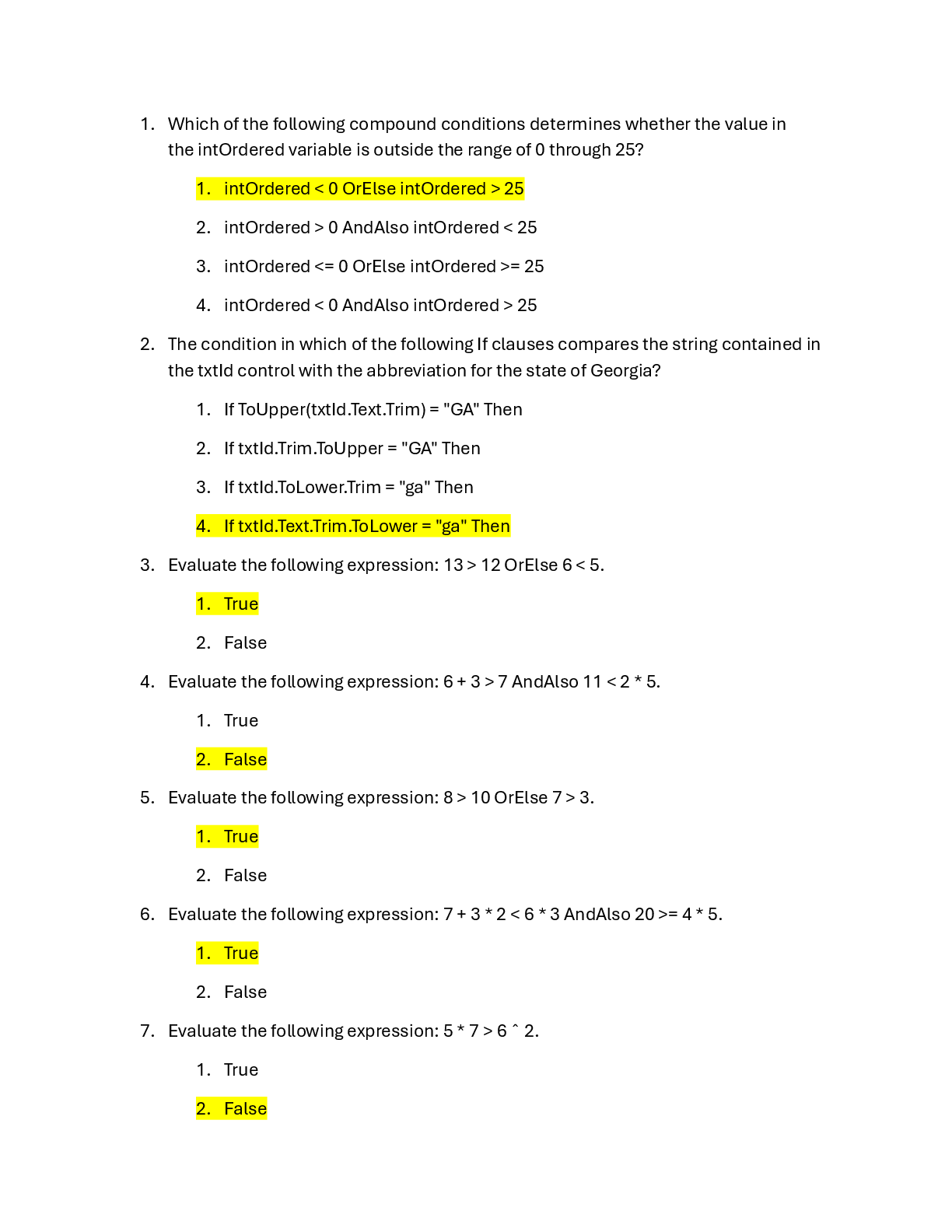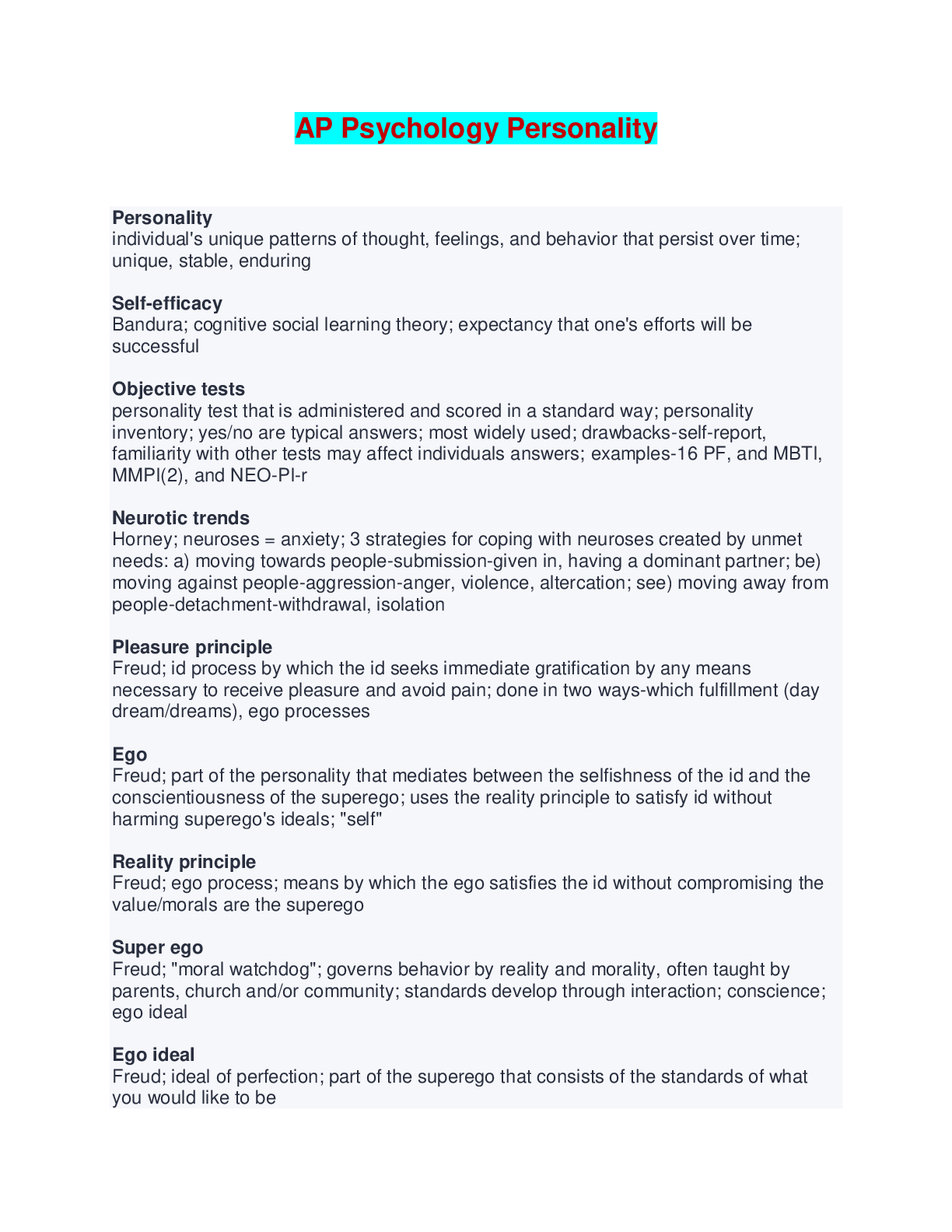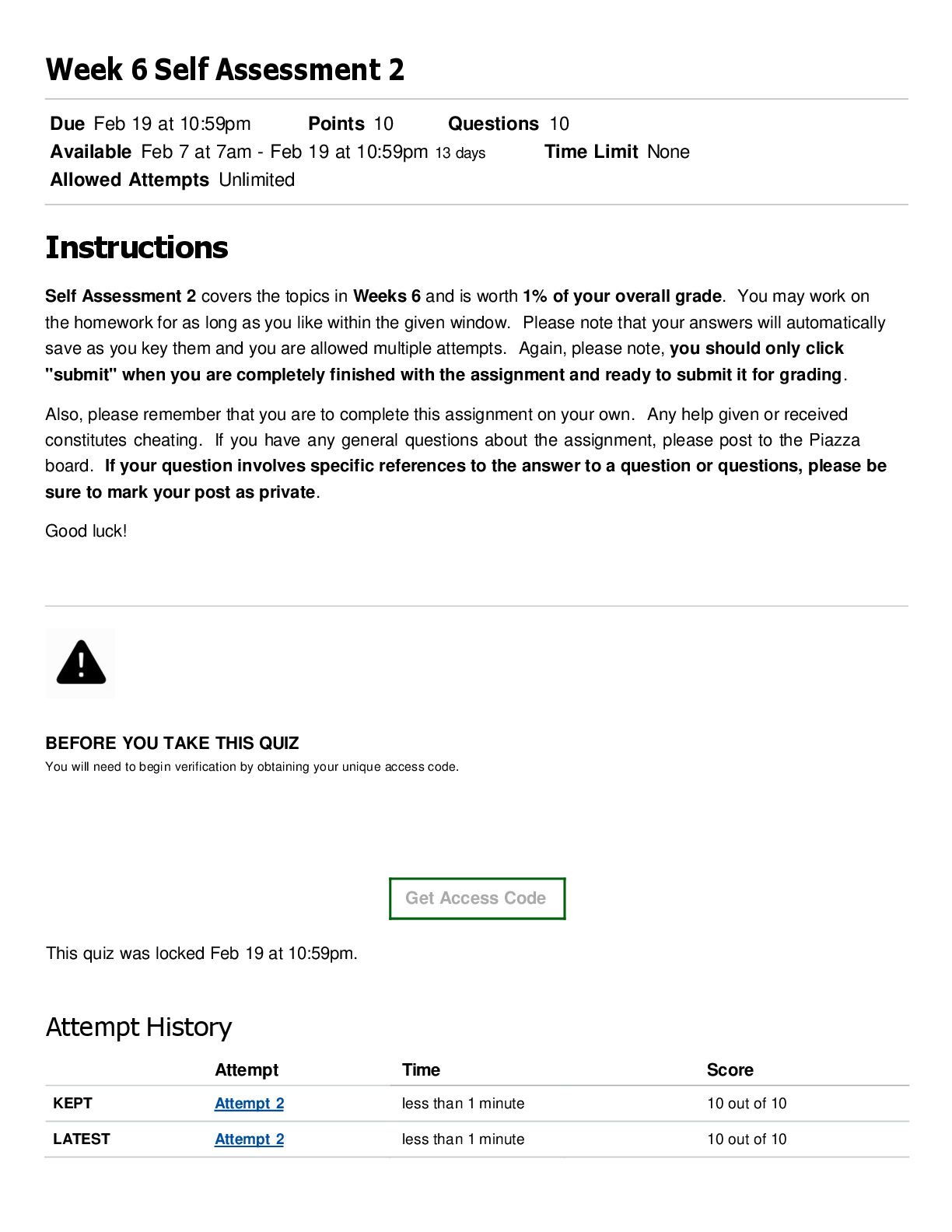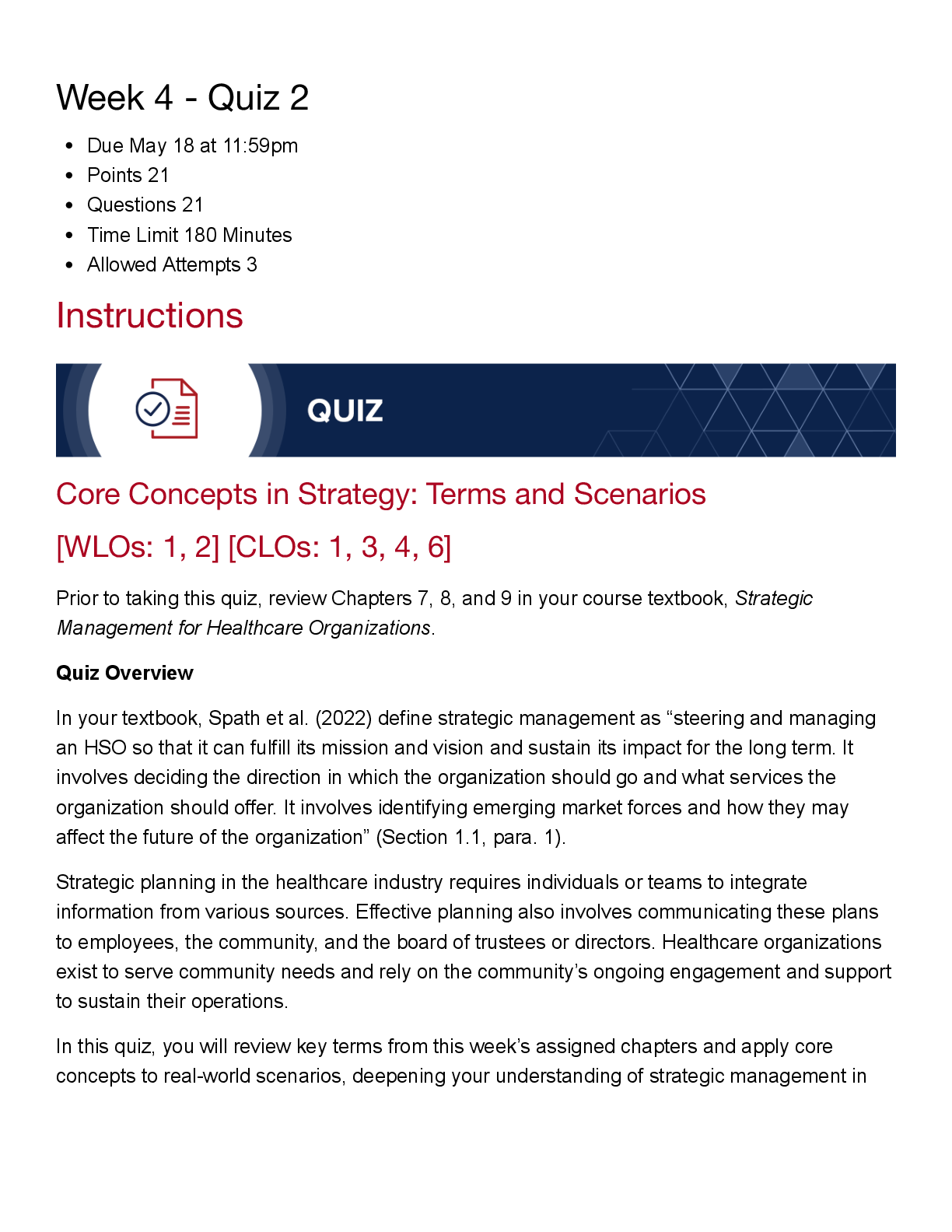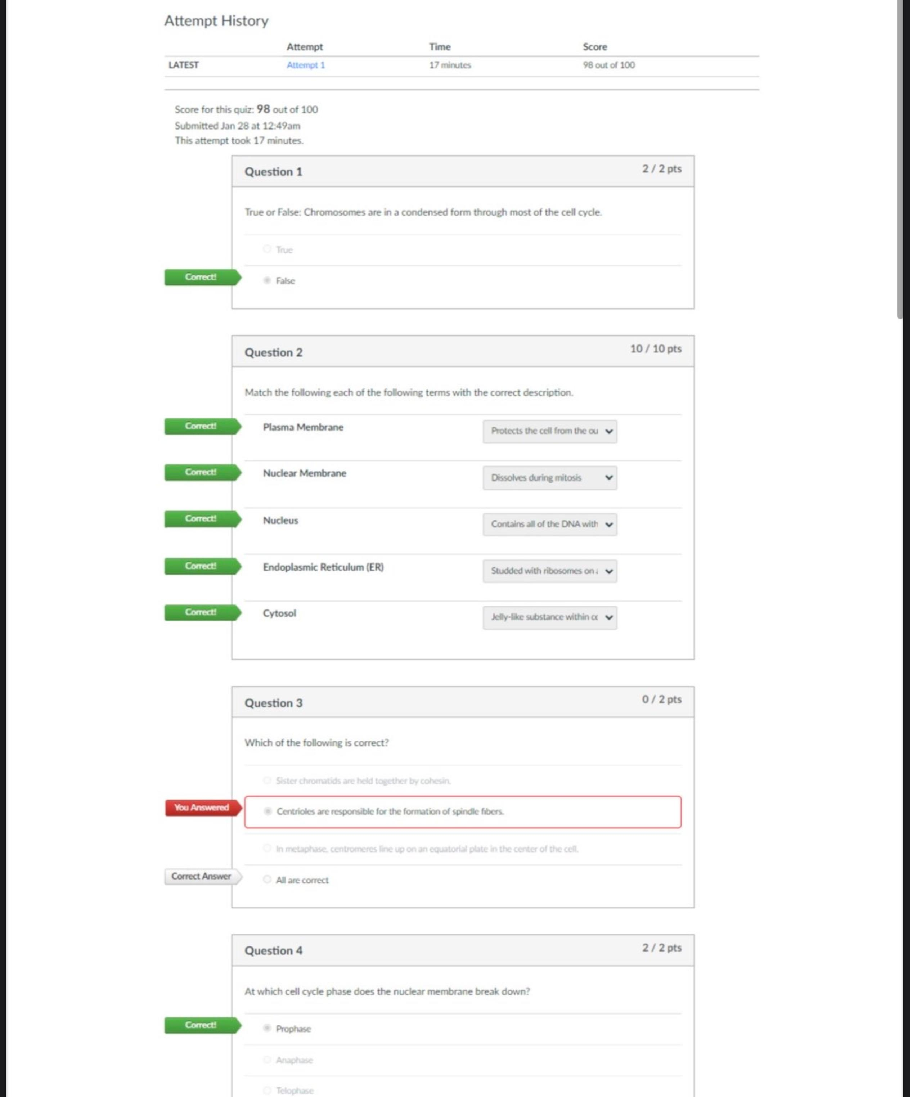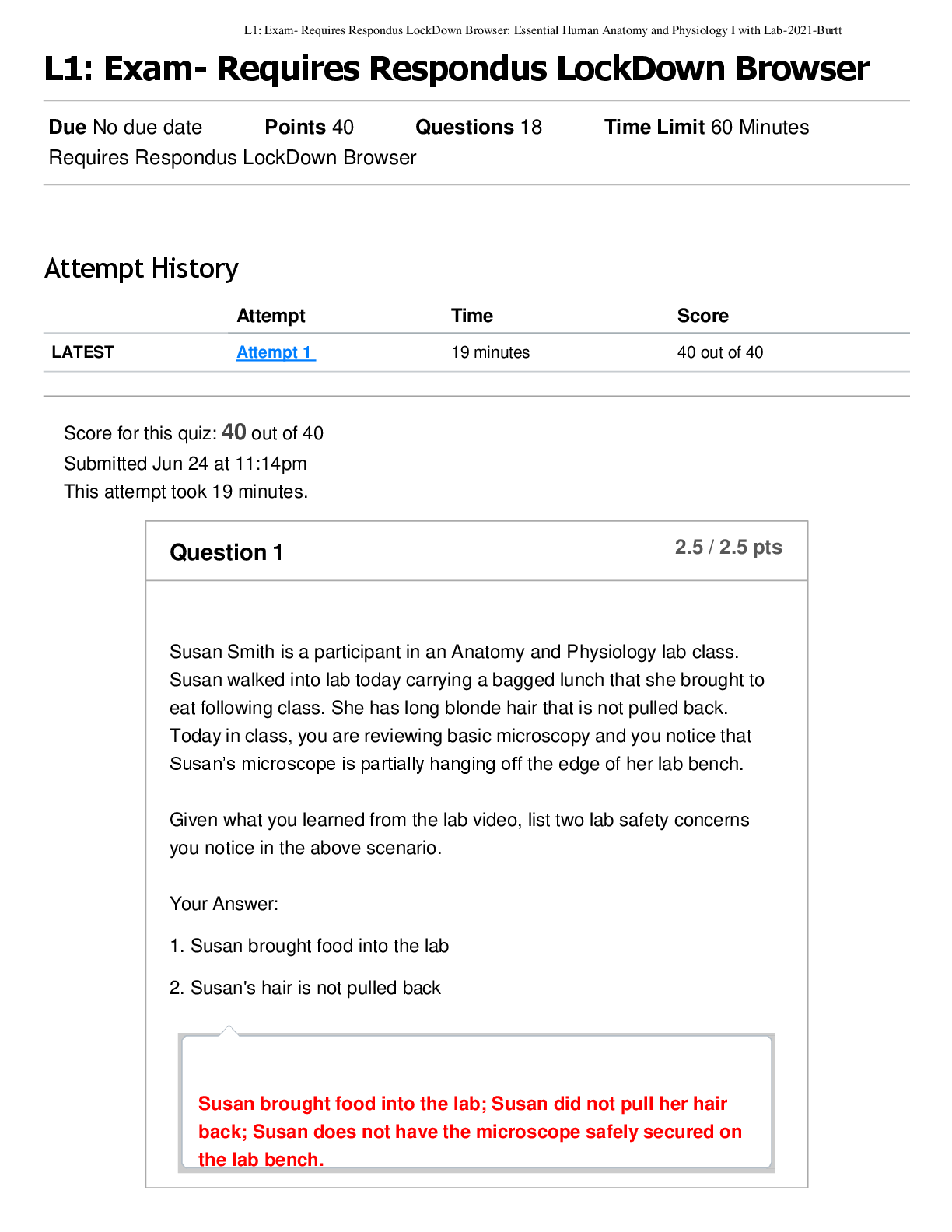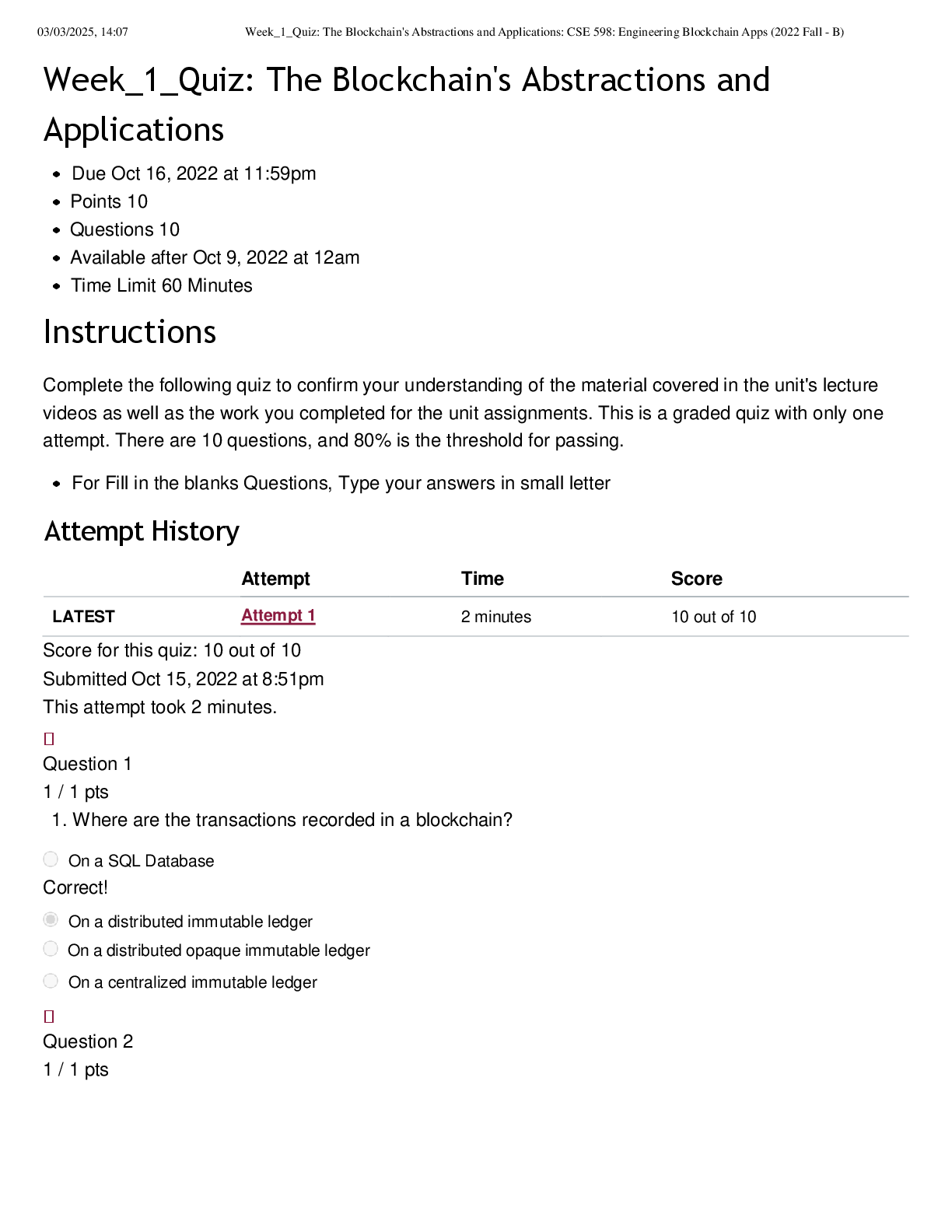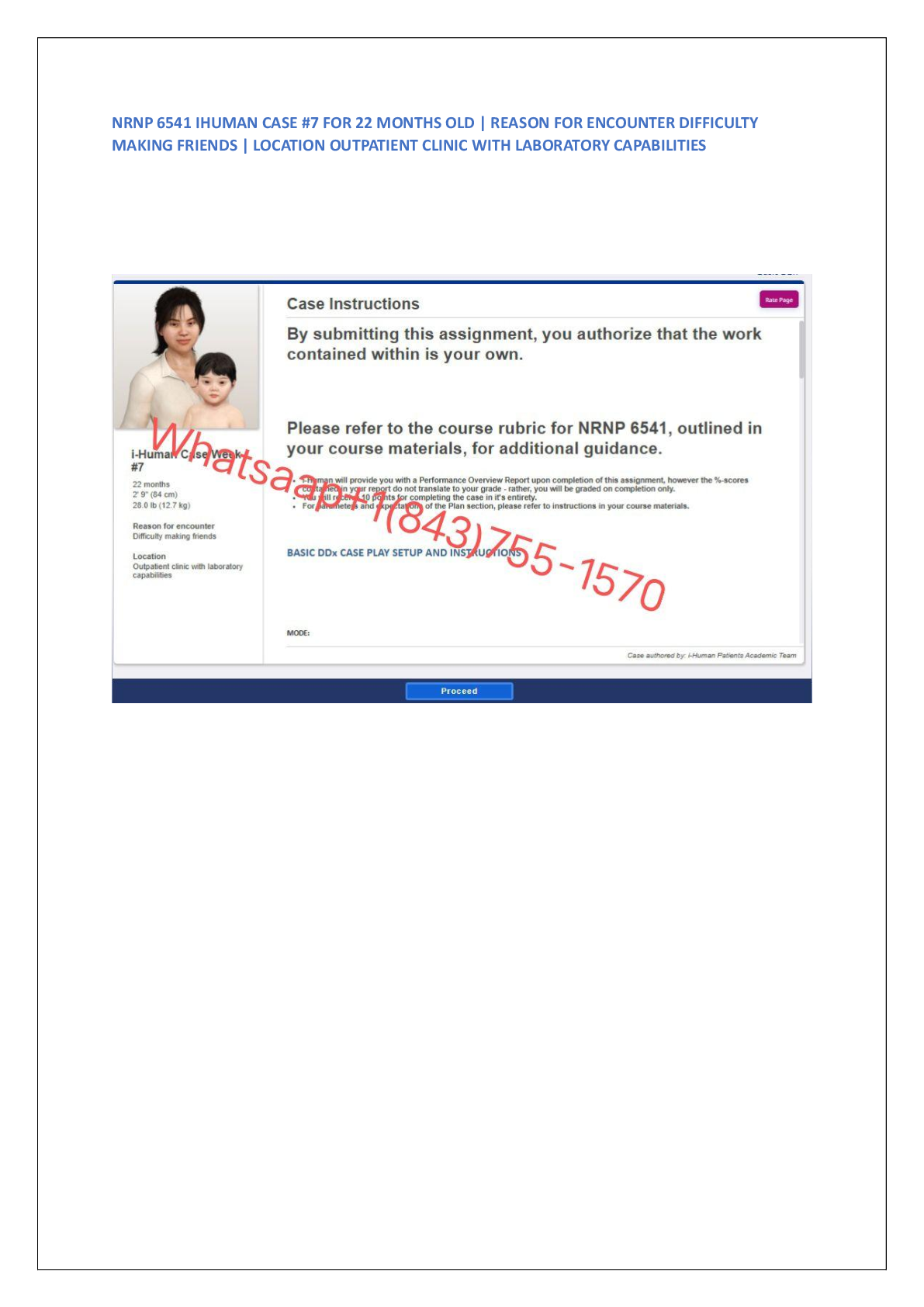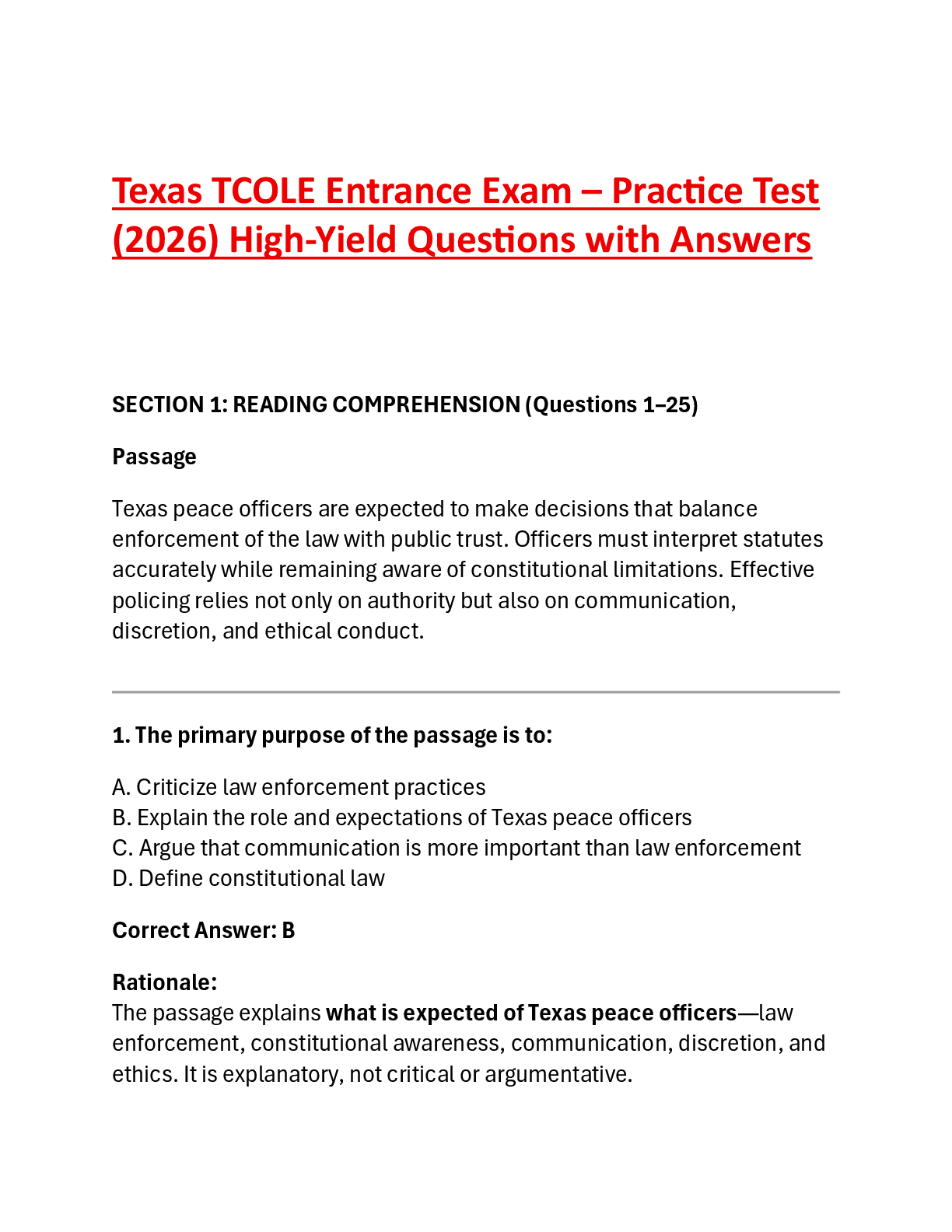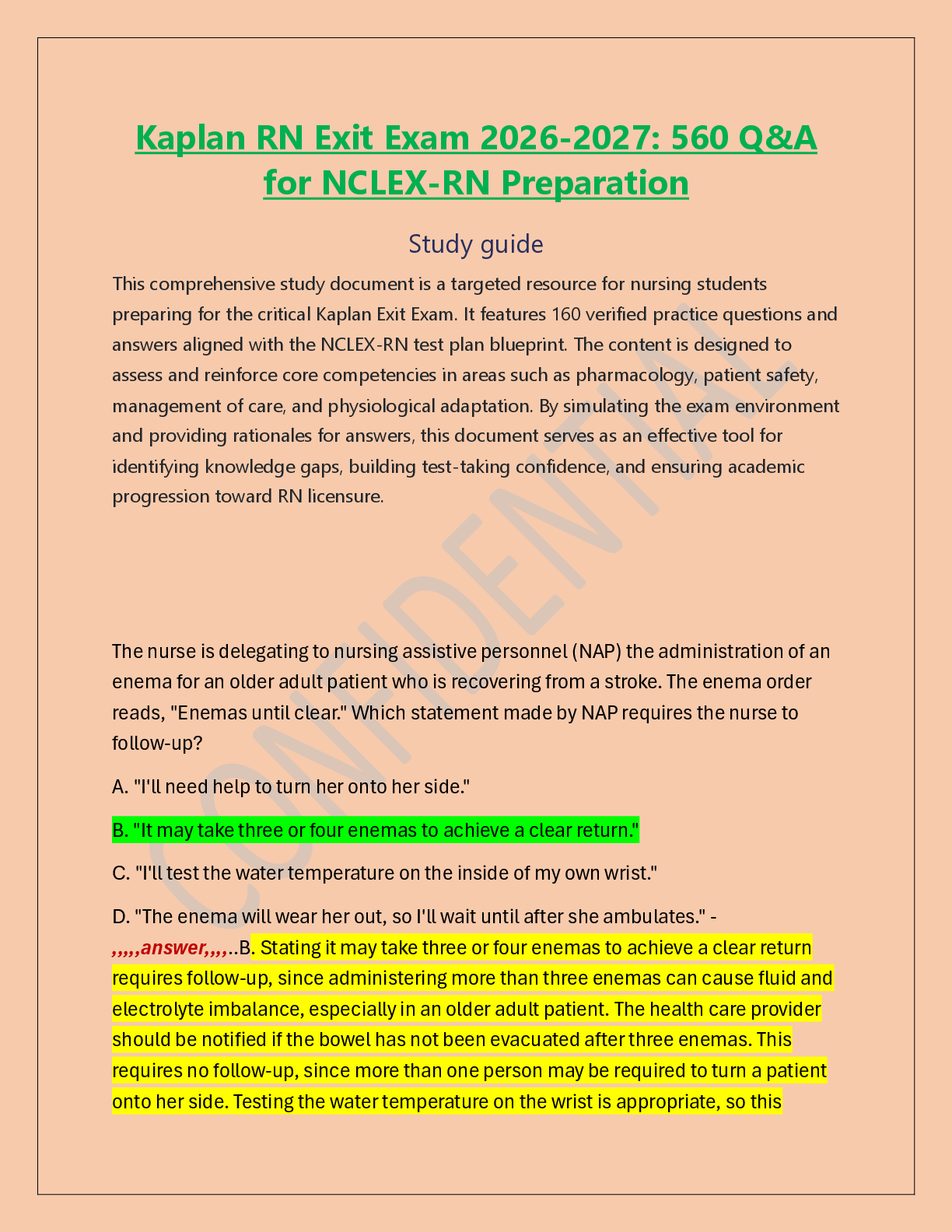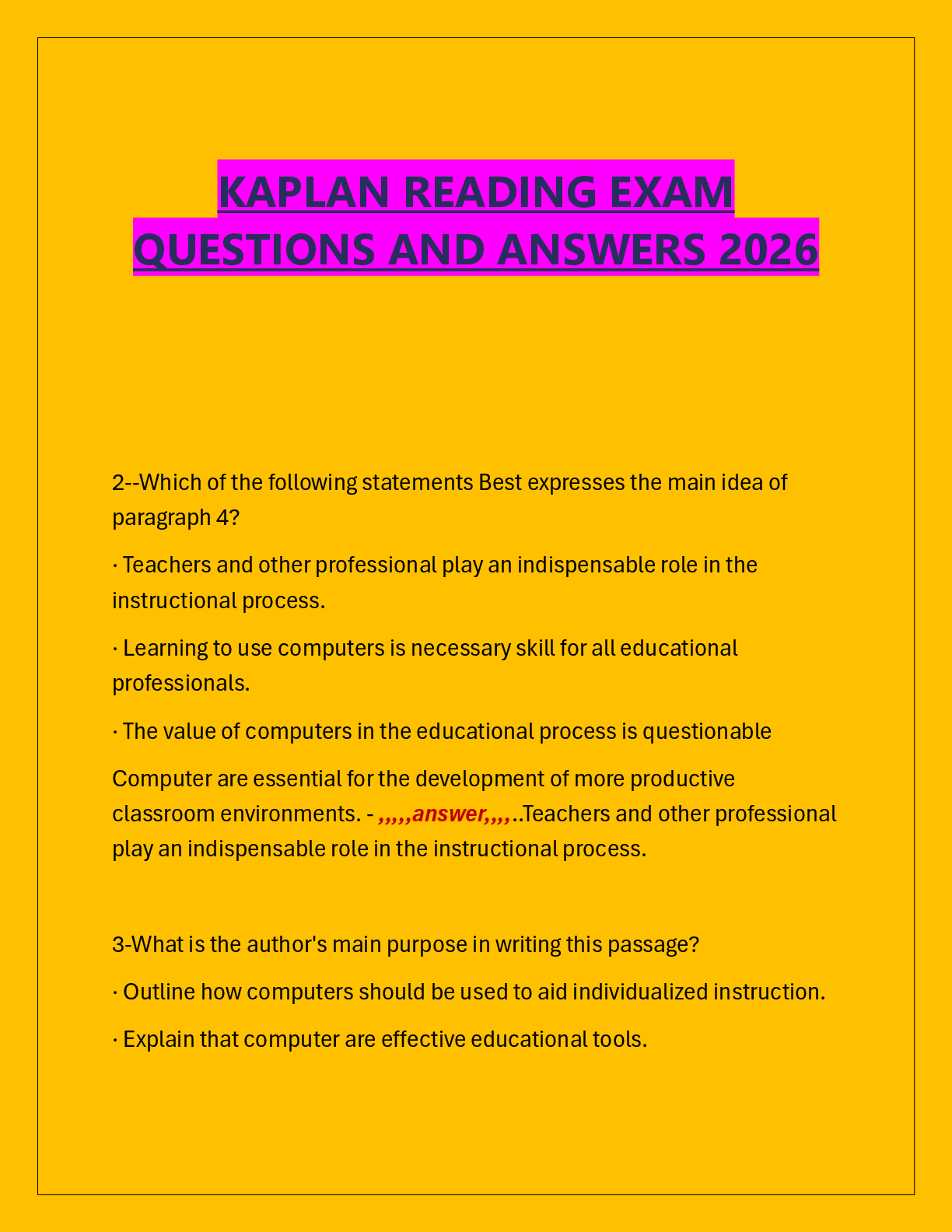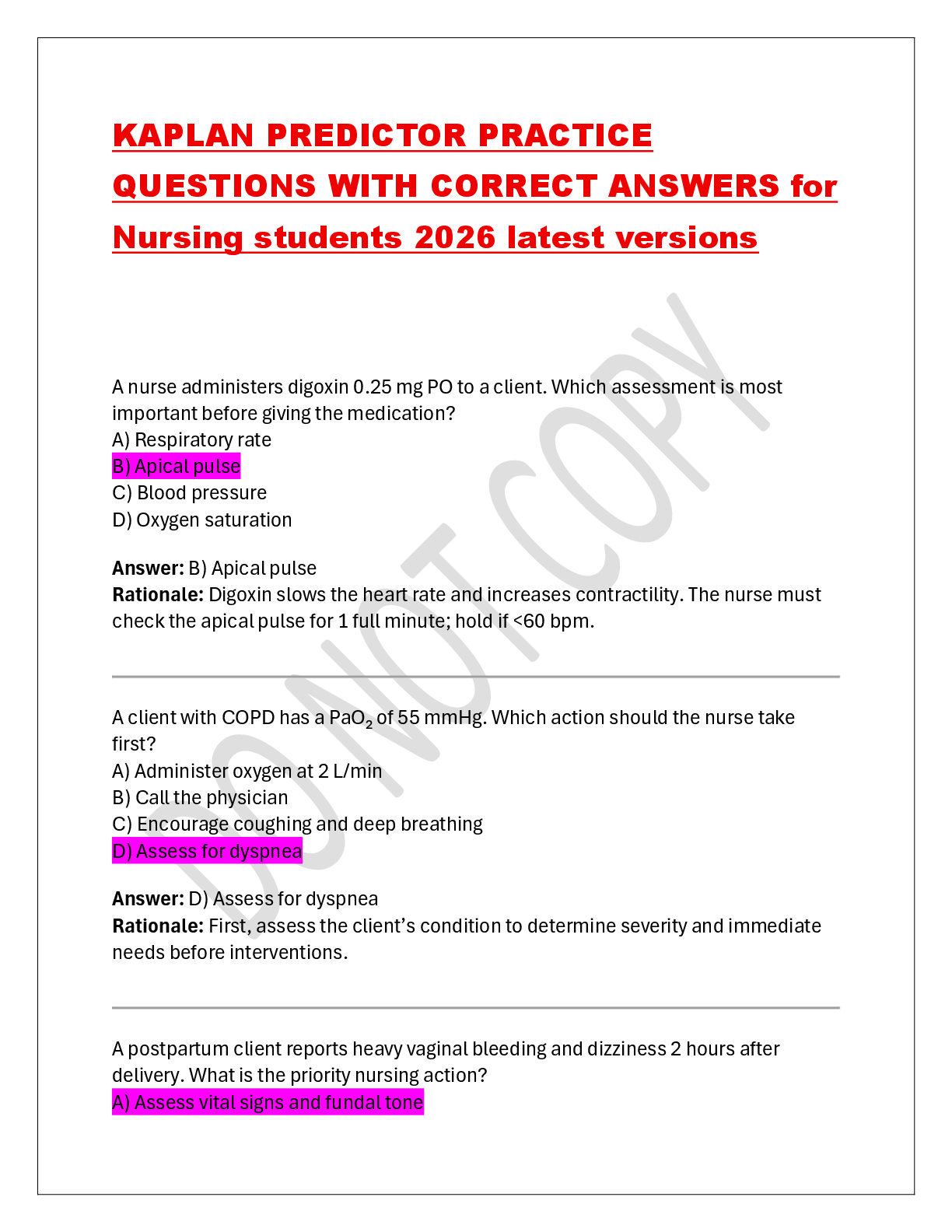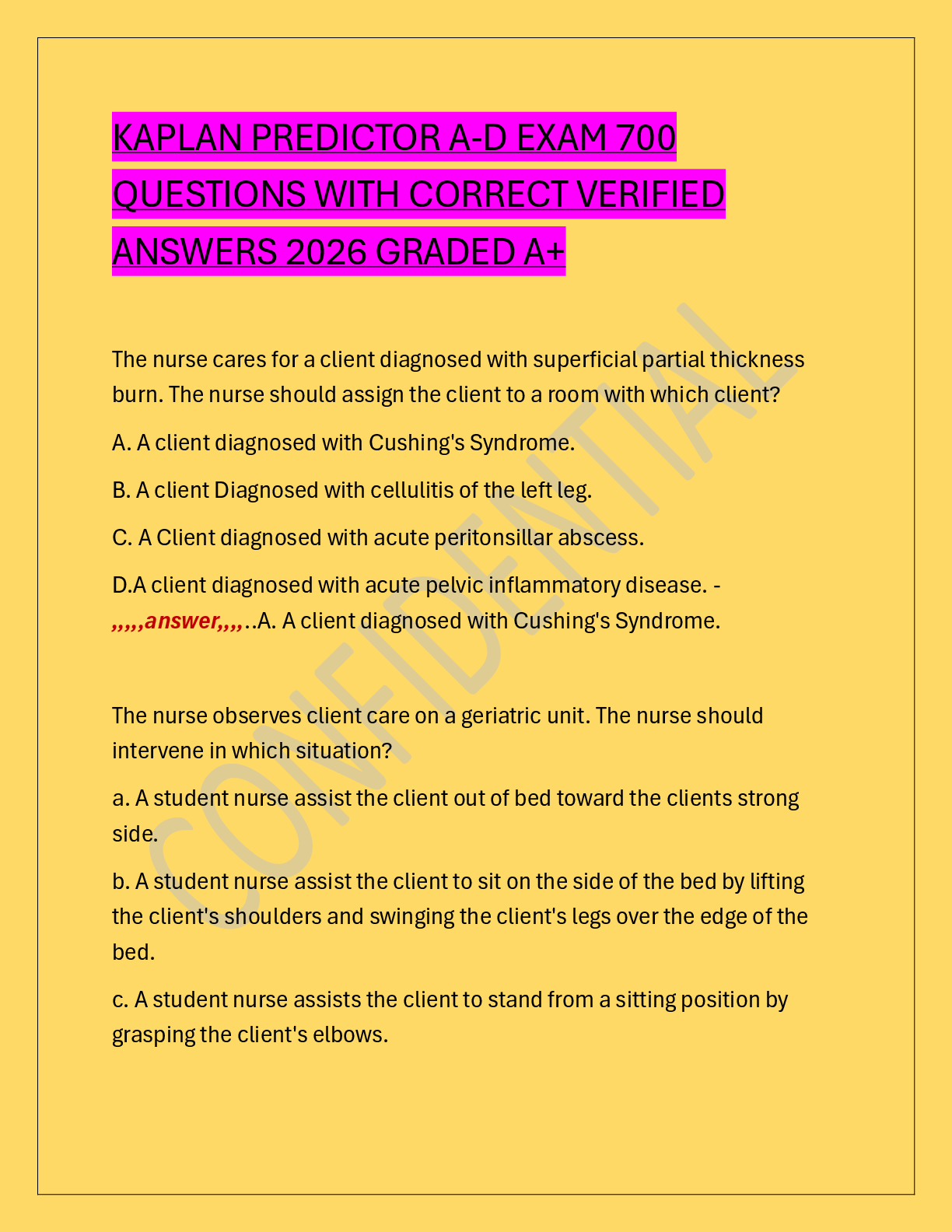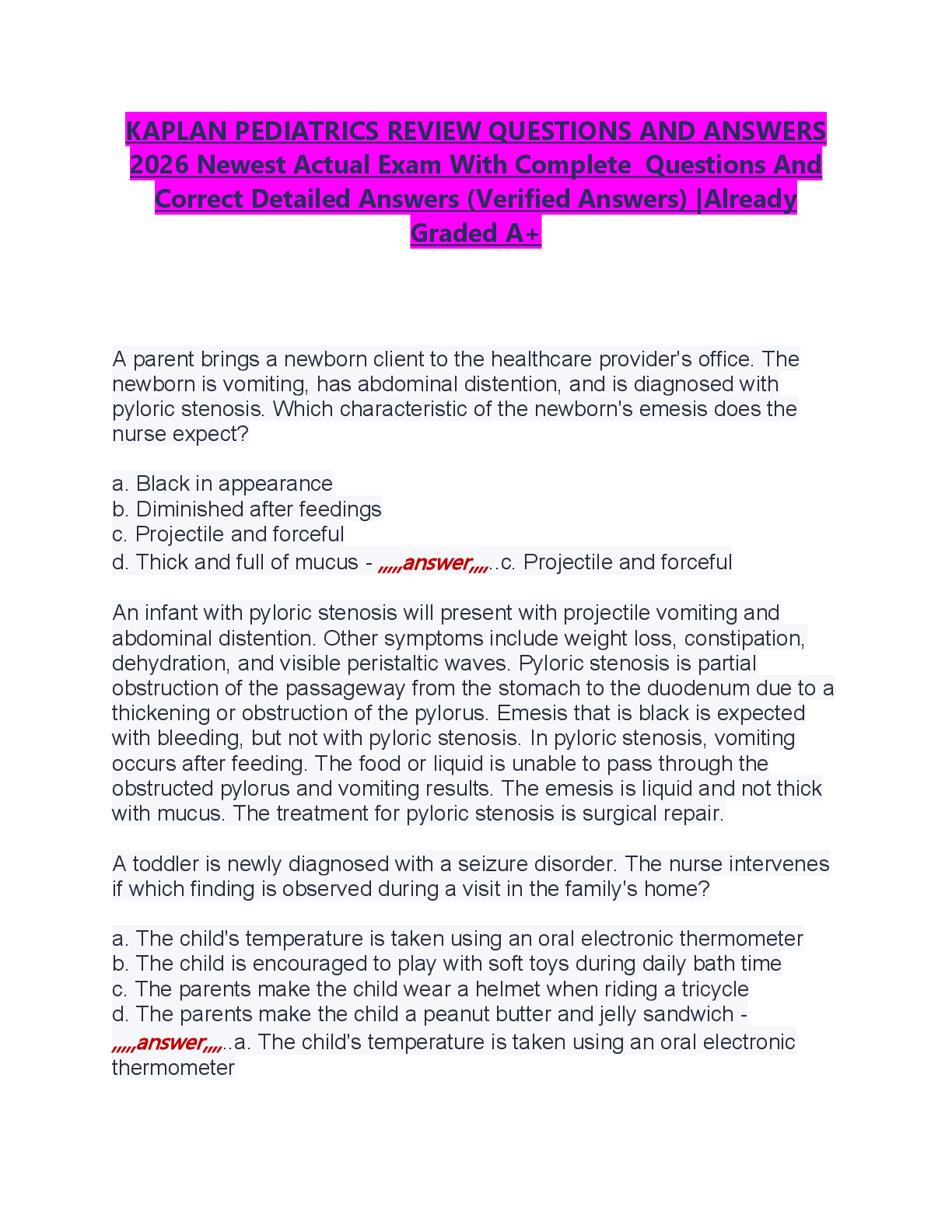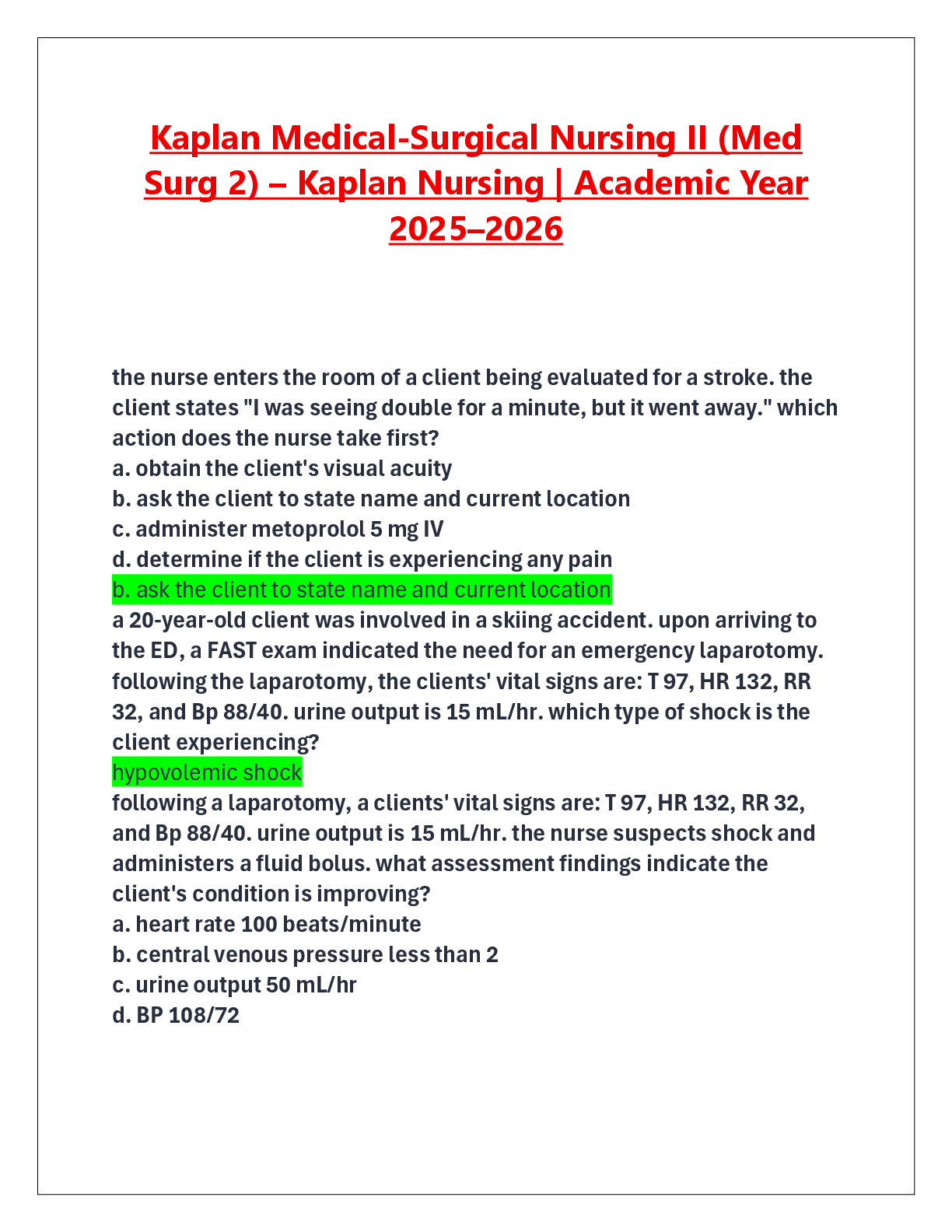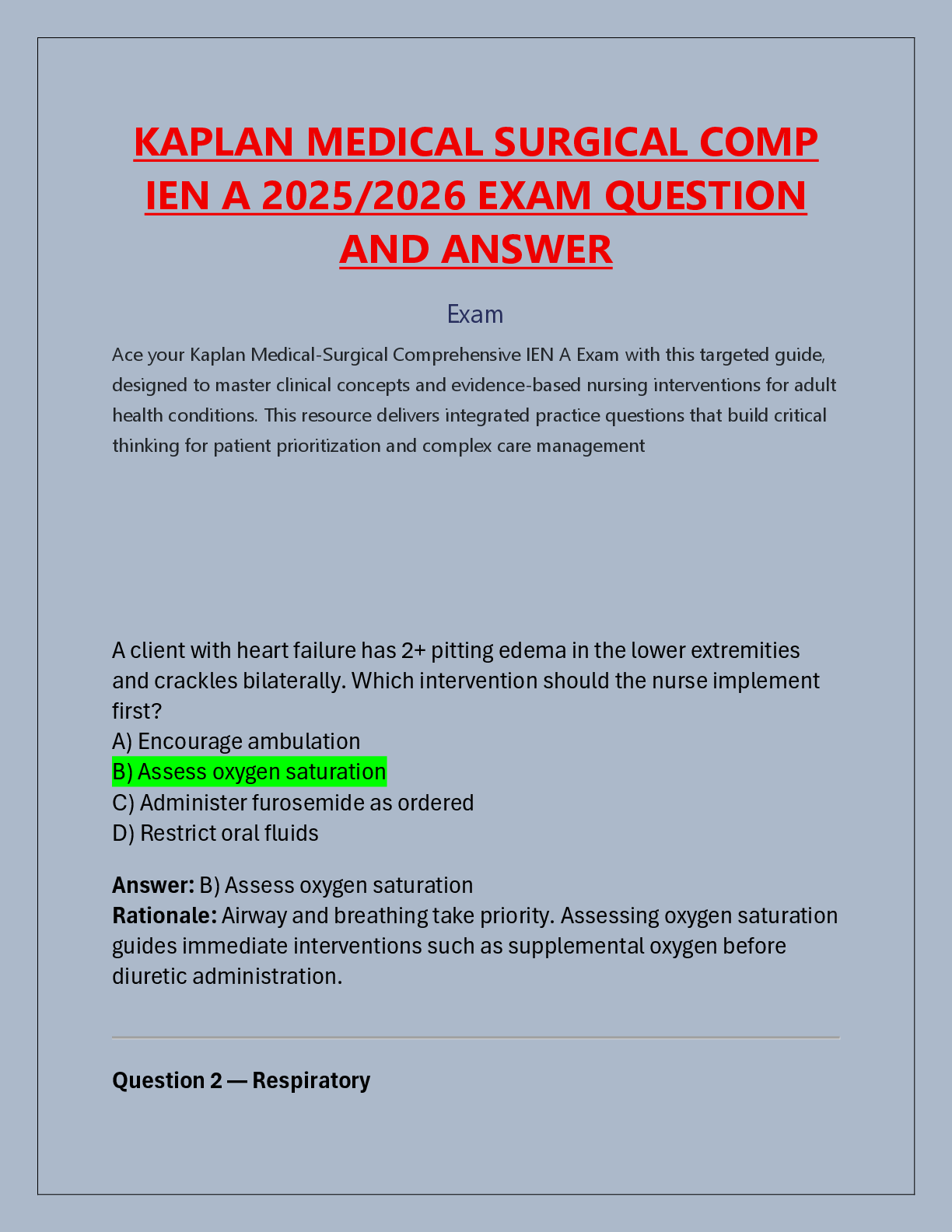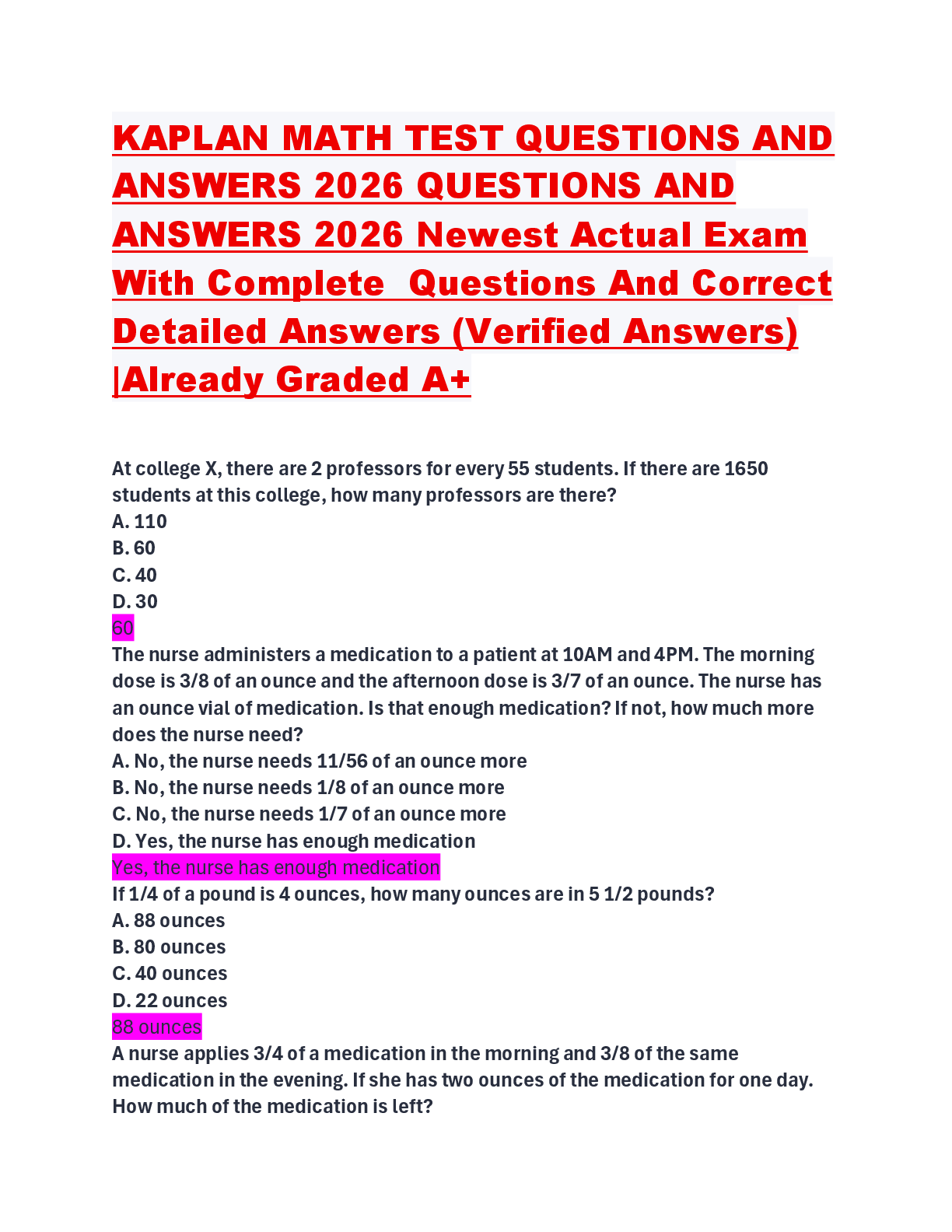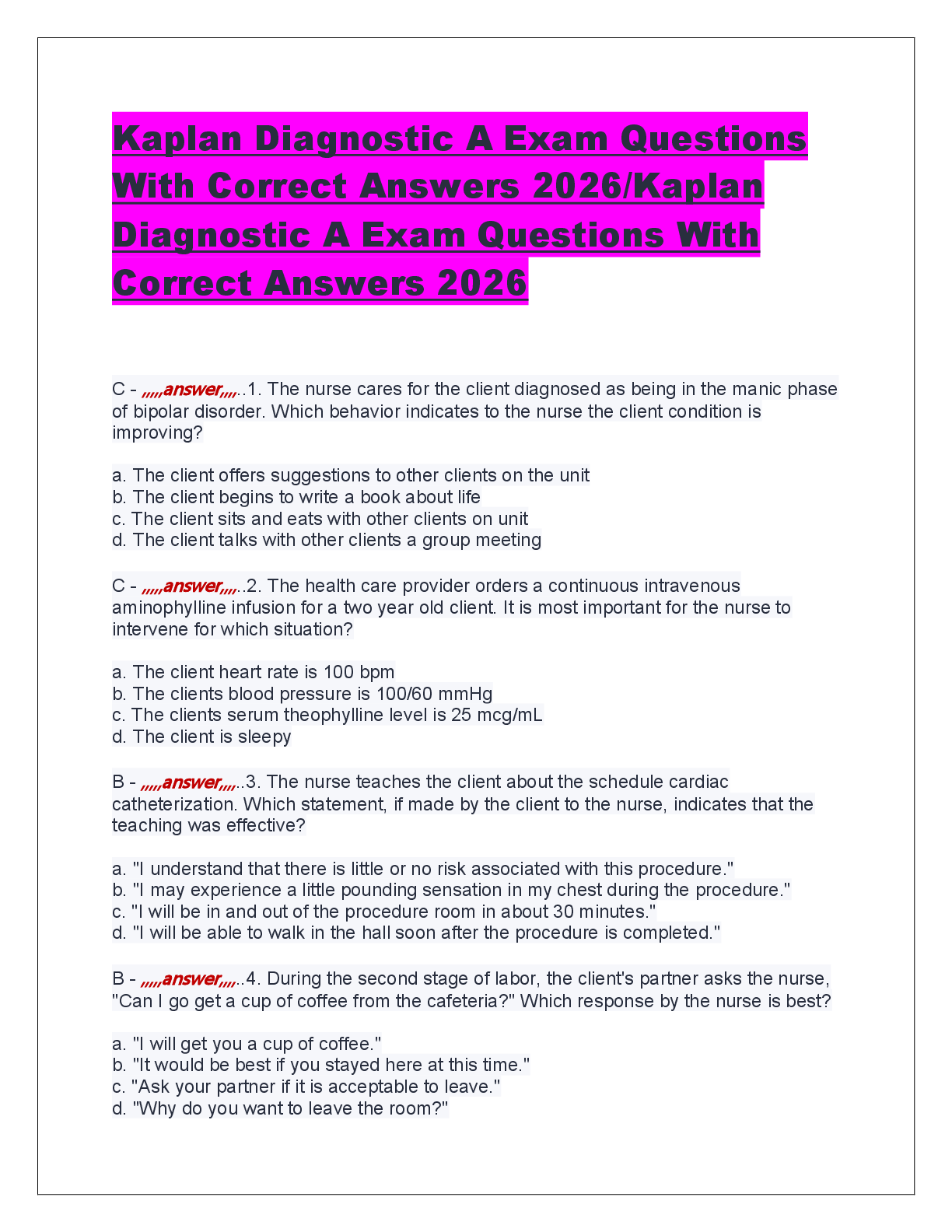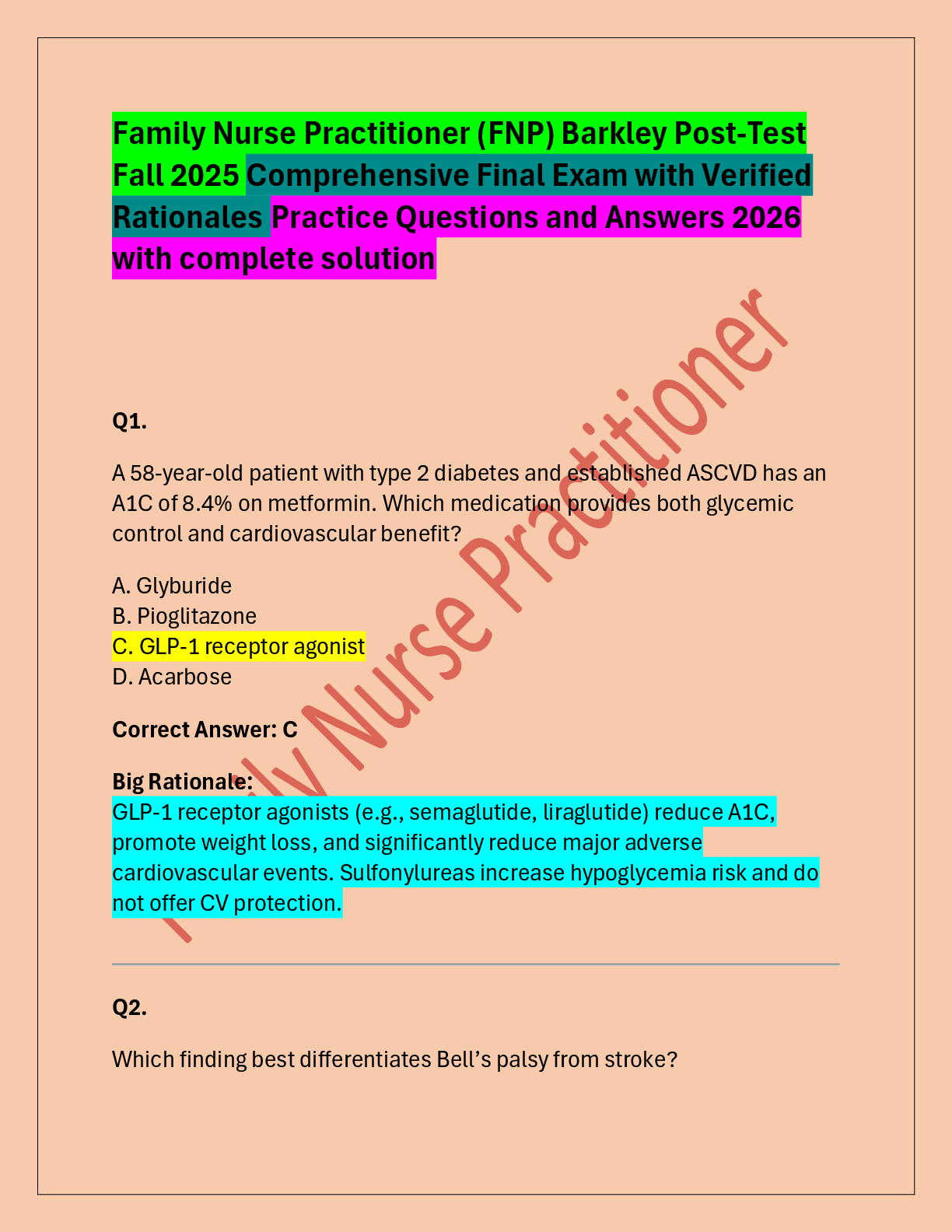Organizational Behavior > EXAM > BUSMHR 3200 Exam 1 Inks | Complete Solutions (Verified) (All)
BUSMHR 3200 Exam 1 Inks | Complete Solutions (Verified)
Document Content and Description Below
BUSMHR 3200 Exam 1 Inks | Complete Solutions (Verified) Basic levels within the organization individual, team, organization level Derailers -insensitivity to others -poor working relations -inabilit ... y to build or lead a team -authoritarianism -inability to change and adapt Human relations movement -increasing numbers of studies/writings from behavioral scientists focusing on the "human" factor -collective bargaining legalized in 1935; management looking for other ways to manage workforce McGregor's Theory X vs Y one doesn't replace the other; just different perspectives on people Theory x -People dislike work and avoid it whenever possible -People need to be coerced to work -People require close supervision at all times -Most people prefer to be directed, have little ambition and avoid responsibility -top down hierarchal Theory y -Work is seen as a natural activity, like play or rest -Given objectives, people can be very self-directed -People become committed to objectives with some reward -Most people are ambitious and can accept (and seek out) responsibility -in general people think more progressive way of looking at people but different perspectives Strategic Management -A plan for integrating goals, tactics, policies and actions into a meaningful whole -Has two primary elements --Strategy Formulation (designing/developing a strategy) --Strategy Implementation (making it happen/implementation) Strategy Formulation Developing a strategy -starts with a vision -lofty compelling future state they are trying to make Goes into a mission Internal Analysis-strengths/weaknesses External Analysis-Opportunities/threats + vision mission goals = strategic plan SWOT analysis is commonly used here Strategy Implementation Galbraith's Star Model Focuses on 5 critical elements or organization functioning: strategy structure systems & processes metrics & rewards people *all elements need to be aligned for org. to succeed Motivation Psychological (and physiological) processes that underline the direction, intensity, and persistence or behavior of thought Intrinsic Motivation aspects related to the job, internal characteristics of the person, etc. -feelings generated from doing rather than being rewarded -give this to ourselves! Extrinsic Motivation aspects related to rewards, recognition, promotion, etc. -results from the potential or actual receipt of extrinsic rewards Fundamental Equation regarding performance P= A x M x O P=performance A=ability M=motivation O=opportunity This model is multiplicative; needs all three elements to work Need-based theories of motivation -Maslow's Need Hierarchy Theory -Alderfer's ERG Theory -McClelland's Need Theory Maslow's Hierarchy of Needs Abraham Maslow developed this suggests that there are five needs we need as individuals, in a hierarchy Growth Needs: Self-actualization (needs to be all that we can be) Esteem Needs( need to feel good about self) Deficiency Needs: Social/love needs (needs for belongings) Safety needs(physical/psych) Physiological needs (food/water) *not supported, but theory remains popular -can only work on one need at a time Alderfer's ERG Theory Clayton Alderfer Growth needs Relatedness needs Existence Needs *not a strict hierarchy theory, can work on all needs at one time McClelland's Need Theory David McCellend's -motivation is a function of three different needs that vary from individual to individual Need for Achievement Need for Affiliation Need for Power *success in a role often a function of fit between the job and person's needs Need for Achievement (n-Ach) the desire to accomplish something difficult Need for Affiliation (n-Affil) the desire to spend some time in social relationships and activities Need for Power (n-Pow) the desire to influence, coach, teach, or encourage others to achieve Job design approaches to motivation focuses on design of job having implications for improved satisfaction, motivation and performance and reduced absenteeism, turnover, etc. -job enlargement -horizontal growth -job enrichment - vertical growth -job rotation -job crafting -job simplification -job characteristics model *consider "little things" that sometimes go along with these Job Characteristics Model Core Job Characteristics--> Critical Psychological States--> Outcomes Job Satisfaction -an affective or emotional response to one's job -moderately correlated (at best) with most work outcomes/measures Satisfied employees may not necessarily be high performing, innovative, enthusiastic, etc. Employee engagement -assumes satisfaction plus a level of excitement and enthusiasm about the work, energy/enthusiasm for the organization, and passion for what one does -more strongly correlated wit positive outcomes than satisfactions *better measure of commitment or discretionary effort Equity Theory -has its roots in cognitive dissonance theory -can help explain a large number of motivation situations -FOCUSES ON PERCIEVED FAIRNESS, JUSTICE IN SOCIAL EXCHANGES outcomes- what one fets from job (tangible and intangible) inputs - what one puts into the job outcomes/inputs ratio - can be equitable or inequitable -can create dissonance and motivate behavior Ways to reduce inequity -you could ask for a raise -you could reduce your inputs -you could somehow get "beth's" input raised -you could (somehow) get Beth's outcomes lowered -you could realize that there are intangibles that might alter this too Expectancy Theory Effort (Down narrow)-expectancy - probability you believe that hard work will lead to performance Performance-expectancy, - perform well and will reward for it Outcome/rewards- valance of outcome, reward =motivation Goal Setting -should be difficult and ambitious, but achievable -as much as possible, try to quantify and use the SMART acronym -provide feedback (positive and constructive) -use whatever method seems appropriate -follow up regularly -treat employees equitably depending on goal attainment SMART Specific Measureable Attainable Relevant Time-based Compensation the rewards, usually monetary in nature (either short-and/or long-term) that reinforce behavior, organizational membership, performance, and retention *intensely personal and related to self-worth Merit Pay -link performance-appraisal ratings to annual pay increases -important conditions required: individual performance can be measured, increases decided equitability based on performance -salary Incentive Pay -variable compensation/bonuses -can be supplemental income or sole source of income -typically linked to some previously-set performance targets, accountabilities, etc. -include senior level non-exempt -primary - total commission -secondary- leasing Bonuses elements funding: organization targets need to be met with fund bonus pools distribution: bonus pools distributed according to plan, targets, etc. Employee stock ownership plans employee ownership plans that give employers certain tax and financial advantages when stock is granted to employees Profit Sharing -payments are based on a measurement of organization performance (profits), and payments do not become part of base pay -it may encourage employees to think more like owners -can enhance feelings or procedural and distributive justice -drawback is that employees may not see strong link between their performance and organization performance -can also be seen as an "expected" element of compensation Benchmarking -comparing one companies best practices to another -both for program development and ongoing pay competitiveness is important for best possible programs Importance of benefits -grown in importance and variety and expectation -don't necessarily affect an employee's performance, inadequate -can lead to dissatisfaction and turn over -add apx. 40% to an orgs. payroll cost -progressive programs reflect diversity of workforce -serve as potential differentiators for companies including small and mid-sized orgs Group two or more freely interacting individuals who share norms and goals and have a common identity Group benefits-individual -greater availability of, and access to, resources, etc. -affiliation -security and protection -self-esteem and sense of identity -problem solving Group benefits-organization -task accomplished (couldn't be done by 1 person) -increased creativity and innovation -increased collaboration -(usually) better decision making -helps socialize newcomers Common roles played in group setting -task-oriented -maintenance -individual Task-oriented roles -initiator -energizer -info seeker -opinion giver -elaborator -evaluator -recorder Maintenance roles -harmonizer -compromiser -encourager -gatekeeper -commentator Individual roles -blocker -recognition seeker -dominator -evader Tuckerman's Model of Group Development 5 stages -forming -storming -norming -performing -adjourning (for temp. teams) Gersick's Punctuated Equilibrium Model Group development follows a pattern: -first meeting -inertia (typically doing very little) -increased levels of activity -more inertia/consistency in behavior until close to deadline -frenzied activity to complete project Team a small number of people with complementary skills who are committed to a common purpose, performance goals, and approach for which they hold themselves mutually accountable Team in comparison to group -leadership is an activity shared by everyone in the group -group members are help accountable for individual and team results -the group defines its own mission, objectives, etc. -the group is focused on problem solving and continuous improvement -the group views effectiveness and success in terms of their collective productivity, outcomes, etc. Types of teams -production -problem solving -management/leadership -cross-functional -self-managed -virtual High-performance teams -relatively small (10-12 ppl) -members have specific skills -roles are allocated across team members -commitment to a common purpose and set of goals -reward systems reinforce team vs. individual behavior -high levels of trust within the team -shared pride and "esprit de corps" Group/team decision making advantages -more info -more diversity/perspective -division of labor/sharing of resources -greater change for high quality decisions -increased acceptance of solution by group members -higher perceived legitimacy and objectivity Group/team decision making disadvantages -more time than individual decision making -decision may not be reached in extreme cases -potential for interpersonal conflict -potential pressure to conform -diffusion of responsibility -potential for groupthink Group cohesiveness -severity of initiation into the group -high external threat or competition -time spent together -high skill levels (core & complementary) -shared respect for each other's skills and capabilities -smaller (vs. larger) groups -longer (vs. shorter) groups -history of success Brainstorming a technique to increase group creativity and productivity by encouraging group members to express their ideas in a non-critical and "safe" environment 4 rules for brainstorming -avoid criticizing other peoples ideas (voice of judgement) -share all suggestions even if they are out there -offer as many comments as possible -build on others ideas to create your own Team building -a process designed to improve teamwork and increase group cohesiveness -cant be used within and/or across groups Different approaches to team building -single event/discussion (during staff meeting) -recreational activity (bowling) -low-key offsite (recreating + focused discussion) -intensive offsite experience (intense discussion) -outdoor experience (high ropes course) Social Security -a federal insurance program that provides benefits to retired people and those who are unemployed or disabled. -we pay into this (pension) -goes into a fund Unemployment compensation when you lose your job and it's not your fault, money that is substituted for wages or salary, paid by state of federal agency or workers labor union Workers compensation a form of insurance required from employers that provides money as compensation for workers who are injured at work or contract an occupational disease FMLA (family medial leave act) gives you time to take care of family without the risk of losing job; sick relative etc. HMO (health maintenance organizations) Medical staff that is part of organization itself na pay money to them to replace cost they'd be hit with if they didn't pay replace costs charged by professionals, low premium PPO (preferred provider organization) caps cost of procedures Provides cap cost specific procedures at a certain level CDHP (consumer-driven health plan) Plans that try to pass decision making onto you, employer gives money you spend decision making is put on you, employers money given to you to spend, pay full price HDHP (high deductible health plan) more so for catastrophe ERISA (employee retirement income security act) give you 3 months to find a new job, they cover health care that you had from previous employer, pay 100% CORBA (consolidated omnibus budget reconciliation act) a federal law that establishes minimum standards for pension plans in private industry and provides for extensive rules on the federal income tax effects of transaction associated with employee benefit plans -allows you to continue with previous health care plan, if lsoe job but pay for premiums yourself Affordable Care Act goal is to expand coverage, control health care costs, and improve the systems used to deliver health care, requires organizations with 50 or more full time employees to offer healthcare coverage IRA (individual retirement account) allows individuals to direct pretax income towards investments that can grow tax-deferred; no capital gains or dividend income is taxed until is withdrawn Roth IRA an individual retirement account allowing a person to set aside after-tax income up to specified amount each year. Both earnings on the account and withdrawals after are 59 and a half are tax-free 401K qualified employer-established plan to which eligible employees may make salary deferral (reduction) contributions on a post-tax/or pretax basis Other benefits -vacation, holiday and personal leave -military leave: can serve w/o losing job -disability insurance: long and short term -group term life insurance -travel insurance -services -unconventional/novel -flexible spending account Benefits (Besides Being Legal and Safe) -make better hiring/placement decisions -helps insure fairness in decision making -helps with reputation and brand (internal and external) -promotes diversity and inclusion -drives consistency in hiring and promotion decisions -helps organizations achieve tactical and strategic goals -drives long term organizational successes Equal pay act of 1963 men and women should be paid the same if they have the same experience [Show More]
Last updated: 1 year ago
Preview 5 out of 29 pages

Loading document previews ...
Buy this document to get the full access instantly
Instant Download Access after purchase
Buy NowInstant download
We Accept:

Reviews( 0 )
$18.00
Can't find what you want? Try our AI powered Search
Document information
Connected school, study & course
About the document
Uploaded On
Sep 18, 2024
Number of pages
29
Written in
All
Additional information
This document has been written for:
Uploaded
Sep 18, 2024
Downloads
0
Views
44

